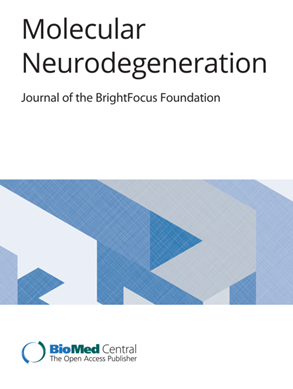Network analysis of the cerebrospinal fluid proteome reveals shared and unique differences between sporadic and familial forms of amyotrophic lateral sclerosis
IF 17.5
1区 医学
Q1 NEUROSCIENCES
引用次数: 0
Abstract
Amyotrophic Lateral Sclerosis (ALS), a neurodegenerative disease involving loss of motor neurons, typically results in death within 3–5 years of disease onset. Although roughly 10% of cases can be linked to a specific inherited mutation (e.g., C9orf72 hexanucleotide repeat expansion or SOD1 mutation), the cause(s) of most cases are unknown. Consequently, there is a critical need for biomarkers that reflect disease onset and progression across ALS subgroups. We employed tandem mass tag mass spectrometry (TMT-MS) based proteomics on cerebrospinal fluid (CSF) to identify and quantify 2105 proteins from sporadic, C9orf72, and SOD1 ALS patients, asymptomatic C9orf72 expansion carriers, and controls (N = 101). To verify trends in our Emory University cohort we used data-independent acquisition (DIA-MS) on an expanded, four center cohort. This expanded cohort of 259 individuals included 50 sporadic ALS (sALS), 43 C9orf72 ALS, 22 SOD1 ALS, 72 asymptomatic gene carriers (59 C9orf72 and 13 SOD1) and 72 age-matched controls. We identified 2330 proteins and used differential protein abundance and network analyses to determine how protein profiles vary across disease subtypes in ALS CSF. Differential abundance and co-expression network analysis identified proteomic differences between ALS and control, as well as differentially abundant proteins between sporadic, C9orf72 and SOD1 ALS. A panel of proteins differentiated forms of ALS that are indistinguishable in a clinical setting. An additional panel differentiated asymptomatic from symptomatic C9orf72 and SOD1 mutation carriers, marking a pre-symptomatic proteomic signature of genetic forms of ALS. Leveraging this large, multicenter cohort, we validated our ALS CSF network and identified ALS-specific proteins and network modules. This study represents a comprehensive analysis of the CSF proteome across sporadic and genetic causes of ALS that resolves differences among these ALS subgroups and also identifies proteins that distinguish symptomatic from asymptomatic gene carriers. These new data point to varying pathogenic pathways that result in an otherwise clinically indistinguishable disease.脑脊液蛋白质组的网络分析揭示了散发性和家族性肌萎缩性侧索硬化症之间的共同和独特差异
肌萎缩性侧索硬化症(ALS)是一种涉及运动神经元丧失的神经退行性疾病,通常在发病3-5年内导致死亡。虽然大约10%的病例与特定的遗传突变有关(例如,C9orf72六核苷酸重复扩增或SOD1突变),但大多数病例的病因尚不清楚。因此,迫切需要能够反映ALS亚群发病和进展的生物标志物。我们采用基于串联质谱标记质谱(TMT-MS)的脑脊液(CSF)蛋白质组学方法,从散发、C9orf72和SOD1 ALS患者、无症状C9orf72扩增携带者和对照组(N = 101)中鉴定和定量2105个蛋白质。为了验证埃默里大学队列的趋势,我们在扩大的四中心队列中使用了数据独立采集(DIA-MS)。该扩展队列包括259例个体,其中50例为散发性ALS (sALS), 43例为C9orf72 ALS, 22例为SOD1 ALS, 72例为无症状基因携带者(59例为C9orf72, 13例为SOD1)和72例年龄匹配的对照。我们鉴定了2330个蛋白,并使用差异蛋白丰度和网络分析来确定ALS CSF中不同疾病亚型的蛋白谱如何变化。差异丰度和共表达网络分析确定了ALS与对照之间的蛋白质组学差异,以及散发性、C9orf72和SOD1 ALS之间的蛋白质丰度差异。一组蛋白区分ALS的形式,在临床环境中是无法区分的。另一个小组区分无症状和有症状的C9orf72和SOD1突变携带者,标志着症状前ALS遗传形式的蛋白质组学特征。利用这一大型多中心队列,我们验证了ALS CSF网络,并鉴定了ALS特异性蛋白和网络模块。本研究对ALS的散发性和遗传性原因的CSF蛋白质组进行了全面分析,解决了这些ALS亚群之间的差异,并确定了区分症状性和无症状性基因携带者的蛋白质。这些新的数据指出了不同的致病途径,导致临床难以区分的疾病。
本文章由计算机程序翻译,如有差异,请以英文原文为准。
求助全文
约1分钟内获得全文
求助全文
来源期刊

Molecular Neurodegeneration
医学-神经科学
CiteScore
23.00
自引率
4.60%
发文量
78
审稿时长
6-12 weeks
期刊介绍:
Molecular Neurodegeneration, an open-access, peer-reviewed journal, comprehensively covers neurodegeneration research at the molecular and cellular levels.
Neurodegenerative diseases, such as Alzheimer's, Parkinson's, Huntington's, and prion diseases, fall under its purview. These disorders, often linked to advanced aging and characterized by varying degrees of dementia, pose a significant public health concern with the growing aging population. Recent strides in understanding the molecular and cellular mechanisms of these neurodegenerative disorders offer valuable insights into their pathogenesis.
 求助内容:
求助内容: 应助结果提醒方式:
应助结果提醒方式:


